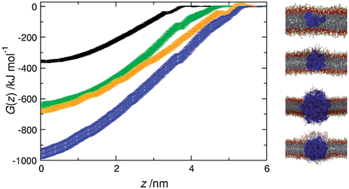Permeation of polystyrene nanoparticles across model lipid bilayer membranes
Abstract
An understanding of the relationship between the physiochemical properties of nanoparticles and their uptake into cells is crucial for realising the potential of nanoparticles for biomedical applications and for developing strategies to minimise human and environmental nanotoxicity. In this work we studied the permeation of lipid bilayer membranes by uncharged hydrophobic polystyrene nanoparticles (PSNPs) as a function of nanoparticle size by means of coarse-grained molecular dynamics simulations. We also investigated the effect of changing the membrane environment by adding cholesterol to the bilayer. Free energy calculations reveal that overall it is energetically favourable for PSNPs to insert into the hydrocarbon interior of dipalmitoylphosphatidylcholine (DPPC) bilayers; however PSNPs with a diameter greater than the bilayer thickness are less readily accommodated than smaller PSNPs. As a PSNP approaches the bilayer there is an increase in the curvature of the bilayer as it bends and partially engulfs the PSNP. The energetic cost of bending is compensated for by the removal of unfavourable PSNP–water contacts. Despite cholesterol increasing the order and rigidity of the bilayer, the interior of the DPPC–cholesterol bilayer appears to be a more favourable environment for PSNPs, possibly due to stronger intermolecular interactions between polystyrene and the model cholesterol molecule than between polystyrene and DPPC.


 Please wait while we load your content...
Please wait while we load your content...